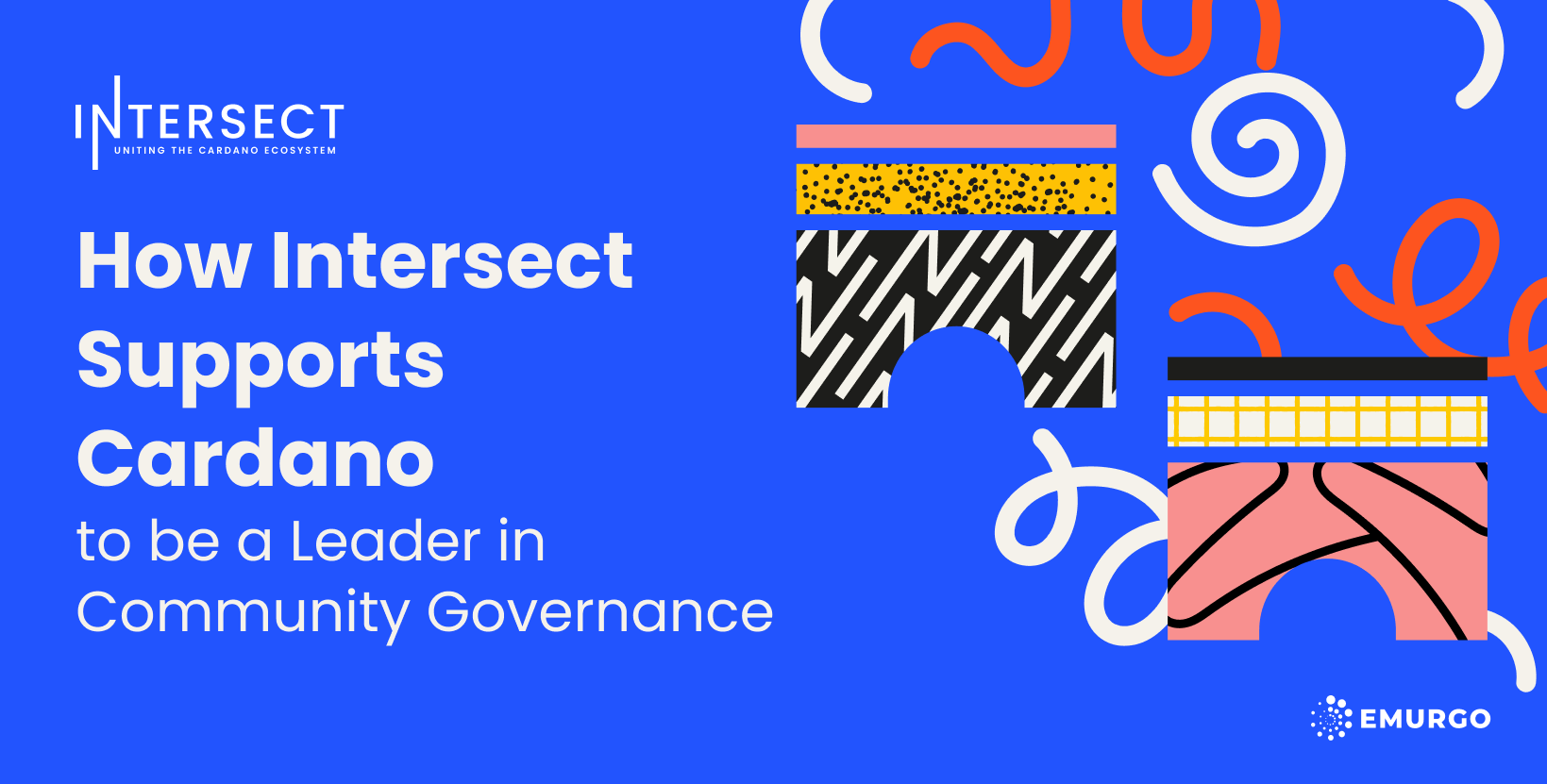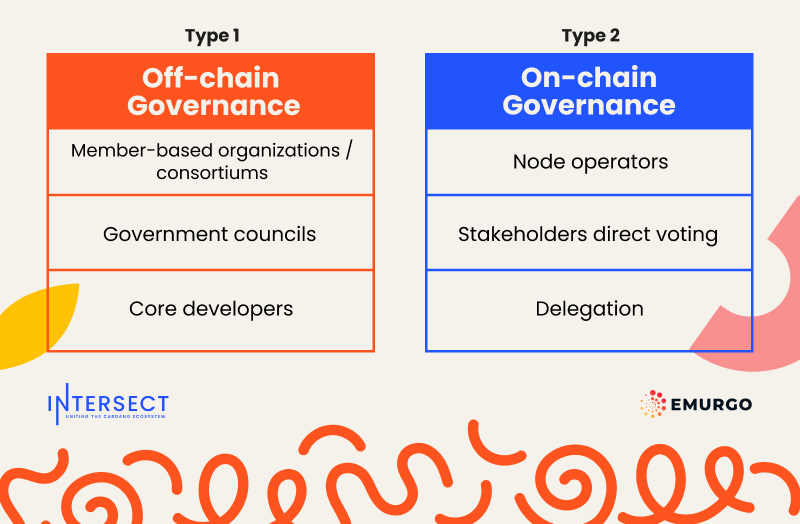How Intersect Supports Cardano to be a Leader in Community Governance
Governance plays an important role when a group of stakeholders such as an organization, corporation, government, etc.

Governance plays an important role when a group of stakeholders such as an organization, corporation, government, etc. Governance deals with the structure and process of enabling the stakeholders to cooperate and function fairly and transparently to achieve the group’s mission.
Many blockchain projects are finding out that creating a sustainable, fair, and distributed governance structure is quite complicated as their communities and developers find themselves at odds with each other as to how to best allocate resources and enable governance to be autonomously run.
This has genuine consequences and can be devastating for the sustainability of a blockchain network as happened with the Block Size Wars and other hard forks happening in other blockchain ecosystems. These splits are very damaging to the community and can have lasting consequences.
So while it’s clear that governance is one of the key components for the success of a decentralized blockchain network, it’s still often overlooked by most blockchain developers. It’s a difficult discussion and one that can have many repercussions for community and network sustainability.
In this blog, we’ll review some of the different Web3 or blockchain governance models and discuss how far they are along. We’ll limit ourselves to models that govern an entire blockchain and not a discussion about DAOs or other mechanisms to control individual projects. In the end, we’ll explain how Cardano’s member-based organization Intersect and its innovative features make Cardano the leader in blockchain community governance.
What is blockchain governance?
According to Merriam-Webster, governance means ”the act or process of governing or overseeing the control and direction of something (such as a country or an organization)”.
In a blockchain network, there is the added requirement that governance must also maintain decentralization or fair distribution among its community members. It must also give a voice to its community members. If these conditions are not met, then the rest of the network may fall prey to the interest of centralized actors.
Additionally, the core developers of a decentralized blockchain have to manage the complexity of decision-making in an international setting, as blockchains are digital domains with no physical borders. A robust governance structure will reduce uncertainty, conflicts, and costs for the stakeholders of the systems.
Stakeholders are also multi-faceted. Some users interact with the network regularly, but also the developers who created the dApps and tools for the ecosystem leveraging the network’s decentralized technology. Finally, there are also infrastructure providers who maintain the network, and the nodes of the network.
A community governance structure for a permissionless blockchain has to balance all the requirements of decentralization, its various stakeholders, and the risks of centralization. Every community member must have a way to participate in governance. In most cases, it is a monumental task that has many facets to be considered.
Blockchain governance models

The blockchain industry has two governance models each with categories of their own. First, we have off-chain governance, and second, on-chain governance.
Off-chain governance
Off-chain governance refers to mechanisms that are outside a blockchain. They rely on other forms of agreements that then are used to resolve disputes, assign resources, or direct development.
Some examples are:
Member-based organizations/consortiums: a group of voluntary organizations with ties to a blockchain ecosystem joining together to foster transparent and accountable governance through voting and regulatory measures, and other initiatives as needed
Government councils: a group of people form a committee and they are the ones that direct a blockchain via votes.
Core developers: a group of developers who work at the low levels of a blockchain network and who maintain the code repositories are the ones who choose the direction of a blockchain.
There are other variations, but all fall under similar designs. Several people or organizations can make changes and make decisions based on some special criteria. The results of votes and decisions sometimes can be public and other times kept hidden depending on the structure.
On-chain governance
On the other hand, we have on-chain governance. This method relies on decisions made by having votes taken by stakeholders directly on top of the ledger. The path to make proposals is also open but normally it requires some sort of criteria such as being a node operator or having a certain amount of cryptocurrency.
The main mechanism for decisions is always voting. The difference is who gets to vote and why are they given this power:
Node operators: in most networks looking to implement on-chain voting, this is only reserved for the node operators. The logic states that since they are the ones maintaining the ledger, their input is what best aligns with the long-term success of a network.
Stakeholder direct voting: under this mechanism, all the participants in a network are given a say on the future of the blockchain. They are divided between representation sectors and voting mechanisms are developed for each one.
Delegation: There is also an option to delegate your vote via different designated representatives.
The concept behind this model is that allowing a plurality of voices to decide ensures the long-term stability of a blockchain.
Intersect: Supporting on-chain governance of Cardano
Intersect is an off-chain member-based organization (MBO) supporting the on-chain governance model of Cardano. It’s an open institution in which any member or organization of the Cardano community can participate. It’s meant to lay the foundations of the future of the network.
The main way Intersect will accomplish this task is by the formation of different committees. The committees and working groups will discuss all the aspects related to governance in Cardano and support distributed community governance in tandem with the implementation of CIP-1694 features for users to easily govern Cardano. Both are essential for the success of Intersect.
Intersect is an open hub for governance discussions. It exists as the vanguard for this topic and it’ll be the backbone of the governance model of Cardano. Participation is open and there are no barriers to joining and contributing. In this way, Intersect is leading decentralized governance discussions on Cardano and across the industry.
Read more: How to get started with Intersect
Intersect committees
The committees are meant to discuss broad aspects of Cardano governance, how to support CIP-1694 (on-chain governance feature proposals for Cardano), and anything else that deals with governance.
They are long-term associations that will continuously improve and discuss the focus area to which they have been assigned such as the Membership Committee, the Community Committee, Open-Source community, etc.
Cardano’s on-chain governance
With the Intersect organization helping to organize and support governance, the next piece of the puzzle is the actual and technical parts of Cardano’s on-chain governance. This part deals with the registration of the SPOs, DReps, and the Constitutional Committee, and the tracking of the votes of the governance proposals. It is the portion that provides the security and audits of the feature proposals outlined and discussed within CIP-1694.
Here Intersect is also providing tools for those looking to participate in the governance process. The main one at the moment is the SanchoNet Governance Portal. A site where community members can register as DReps, delegate their ADA, and track the votes.
It’s all done in the SanchoNet test network, so none of the votes are binding, it’s meant to be a learning playground for the future of governance. It simulates how the final platform will perform and allows the community a place to test and make changes before full release.
Delegate Your Voting Power to FEED DRep in Cardano Governance.
DRep ID: drep12ukt4ctzmtf6l5rj76cddgf3dvuy0lfz7uky08jfvgr9ugaapz4 | We are driven to register as a DRep by our deep dedication to the Cardano ecosystem and our aspiration to take an active role in its development, ensuring that its progress stays true to the principles of decentralization, security, and community empowerment.DELEGATE VOTING POWER!








